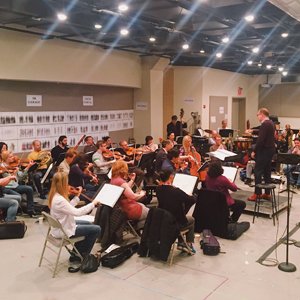Ah, the things one learns at a sitzprobe. A “seated rehearsal” in which singers work with an orchestra before public performances begin, the sitzprobe for My Fair Lady took place this past Sunday in LCT’s large rehearsal hall. It was glorious to hear the performers as they faced a wall of sound, conducted by music director Ted Sperling.
As I watched the proceedings, one thing in particular caught my eye: the musician who was playing both the tuba and the double bass. Plenty of musicians are talented on more than one instrument, but on brass and strings?
During a break, I asked the musician-in-question, Marcus Rojas, about his assignment. His doubling, I found out, was not unusual, at least in the past. “Before advanced sound design came along,” he told me, “it was common for tuba players to know the double bass. They both play a low line, melodically. The double bass couldn’t be heard as well as the tuba, so, depending on the setting, sometimes low notes were played on the tuba and sometimes on the double bass.” Rojas added that Duke Ellington’s band – and other jazz ensembles – would use a tuba for outdoor playing and a double bass for indoor performances. In this context, the tuba was called “brass bass,” as opposed to “string bass” for the double bass.
It is much less common today for musicians to handle both instruments with equal ease. Rojas told me: “I’m a tuba player. But for My Fair Lady I’m also a double bass player. My double bass normally sits in my basement. I take it out from time to time, and I enjoy plucking its strings. But for this show I’ve had to practice bowing as well. It’s a lot harder than plucking.” But the practice paid off. “Before long,” observed Rojas, “I could say what Higgins says: 'I did it!'”
Brendan Lemon is the editor of lemonwade.com.
